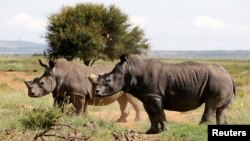A team of U.K.-based scientists is collecting rhinoceros droppings for a new conservation initiative to help prevent global extinction of the endangered species.
In a collaboration dubbed "Saving species with feces," the team from Chester Zoo and University of Manchester aims to identify causes of poor population growth of Africa's "mega-herbivores," including Eastern black rhinos, Grevy's zebras, and Cape mountain zebras.
A major focus for the 1.1-million-pound initiative is the endangered black rhino, a species successfully bred in captivity at Chester Zoo in recent years and whose excrement is a source of useful data to understand the health of the animal.
"Most of the research that we're doing to assess health and stress involves collecting a lot of poo," Professor Susanne Shultz from the University of Manchester told Reuters.
"We want take these models that have been developed on captive animals and apply it to these wild populations ... and assess its relative health and well-being."
The team uses hormonal biomarkers present in animal dung to understand stress and reproductive health in wild animals and they say it can be collected without disturbing the animal.
"Through the poo we can see how stressed the animals are, what condition they are, their individual health, are they reproducing," said Dr. Danielle Gilroy, who is leading a project on another endangered species, the Grevy's zebra.
"All these different factors basically indicate their fitness."
Classed as "critically endangered," there are some 5,000 to 5,400 black rhinos living in eastern and southern Africa, according to the World Wildlife Fund.
The initiative not only hopes to look at the human and environmental impacts on wild populations, with some faring better than others, but also develop a strategy to promote natural reproduction.
"We could not just think about zoos but think of populations in zoos and populations that exist inside their natural range like in Kenya, for example," said Dr. Sue Walker, head of Applied Science at Chester Zoo.
"We think of them as one metapopulation and we can apply the same toolkit to understand why the animals in Kenya might not be breeding as well and what might be impacting reproduction. The most important thing we can do is maximize reproduction in these animals."
Kenya had a rhino population of 1,258 in 2017 of which 745 are black rhinos, 510 are southern white rhinos and three were northern white rhinos, according to the Kenya Wildlife Service.
However, Sudan — the world's last male northern white rhino — died in March in Kenya, leaving only two females of its subspecies alive in the world.





